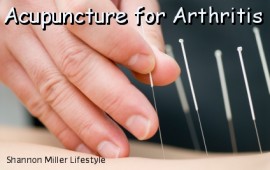Acupuncture for Arthritis
Author: Shannon Miller Lifestyle

By: Stephen Dell-Jones
Arthritis is a very common health condition.
The term arthritis simply means, “joint inflammation”. There are various types of arthritis and a variety of contributing factors, but focusing on arthritis in general and the joint pain and discomfort that accompanies it, we will look at some natural and alternative methods. These methods are acupuncture, nutrition and also a relatively newer but promising method called biopuncture. Traditional Chinese Medicine and acupuncture date back to the beginning of the common era. It was believed that illness was due to the imbalance of energy (or chi) in the body and the Chinese doctors used acupuncture to redistribute that energy throughout the body.
In Traditional Chinese Medicine, arthritis has traditionally been referred to as bone “bi”, or bone pain.
In the Chinese view, environmental factors such as damp, cold, heat and wind “invaded” the body’s joints and caused the pain. Thus chronic joint pain that was made worse with cold damp weather and improved with the application of heat was called “cold damp bi”. Likewise if someone’s pain was made worse with hot damp weather, but relieved with a cold compress it was called “damp heat bi”. There are of course other signs and symptoms that correspond and match the description, such as “damp heat bi” also having redness around the joint and more pronounced swelling. To our modern minds these diagnosis may seem foreign, but today many arthritis sufferers will still agree that factors like dampness and temperature seem to govern their condition. Regardless of how we label the disorder, the methods found back then to treat the joint pain, such as acupuncture, are still valid treatments for many arthritis sufferers today.
Acupuncture is a medical system that has evolved for over two thousand years in Asia, and has a long track record of treating many disorders, including arthritis.
Today acupuncture involves inserting very thin, single use, sterile needles into specific points on the body to stimulate the flow of energy, or chi. In Traditional Chinese Medicine (TCM) theory, the body has many points on its surface that lie on a network of channels. Our body’s energy, or chi, flows along these channels, which also flow through our internal organs. Points on the channels can be manipulated with acupuncture needles and this has several effects such as regulating the neuro-endocrine systems of the body and reducing pain. Traditionally it was said that acupuncture “moves qi and blood”, implying that it helps the circulation, and this effect is helpful in all painful conditions including arthritis.
Newcomers to acupuncture naturally ask questions like, “Does acupuncture hurt?”
The answer is that acupuncture is quite comfortable, and when done by a licensed acupuncturist, acupuncture is free from serious risk. It helps to remember that an acupuncture needle is so thin it can easily fit inside a hypodermic needle, making insertion far less of an ordeal than getting a standard injection. Modern medicine gradually confirms acupuncture’s role in pain management, and today it is being utilized and covered by insurance for this purpose. However, acupuncture is only a part of Chinese Medicine.
Another method the ancient Chinese used was food therapy.
Many people make a conscious effort to eat healthy foods, but may not be utilizing the best options for their condition. The Chinese always observed how the inherent qualities of foods affected the human condition.For arthritis, certain foods were recommended and others were not recommended.
Foods that may help alleviate arthritis are:
- Cabbage
- Celery
- Wheatgrass
- Cherries
- Grapes
- Omega 3 Fatty Acids from Fish and Fish Oils
- Flax Oil
- Kelp
- Chives
- Scallions
- Spirulina
Foods that may aggravate arthritis further are:
- Spinach
- Beet Greens
- Tomato
- Bell Pepper
- Eggplant
- Plums
- Chard
- Rhubarb
- Cranberries
- Alcohol
- Refined Sweeteners
While diet is always an important factor, some people may have deeply seated cases that may require faster acting treatment for relief.
One such method to give fast acting results is biopuncture. Biopuncture is a method that combines homeopathy and acupuncture to provide a potent, natural and effective treatment. In a biopuncture treatment, a small amount of a sterile, homeopathically prepared liquid is injected into an acupuncture point. To treat an arthritic joint, the point chosen would be adjacent to or over the joint. The homeopathic solution injected is a composite containing many ingredients, each designed to help reduce inflammation and benefit the structures of the joint. Some of the more familiar ingredients in the preparation could include the herb arnica montana, and cartilage for example. When ingredients are homeopathically activated, they stimulate the body to heal. The key in homeopathics is the activation of a healing mechanism, not the actual concentration of the substance used. When the homeopathic liquid is injected into an arthritic joint, the benefit of regular acupuncture combines with the benefit of the homeopathic ingredients. Biopuncture has been used safely and effectively in Europe for over two decades, and has the advantages of high patient tolerance and virtually no drug interaction, with reductions in the pain in relatively short periods of time. Between food therapy, Chinese herbal medicine, acupuncture and biopuncture, chronic joint pain can usually be handled naturally.
